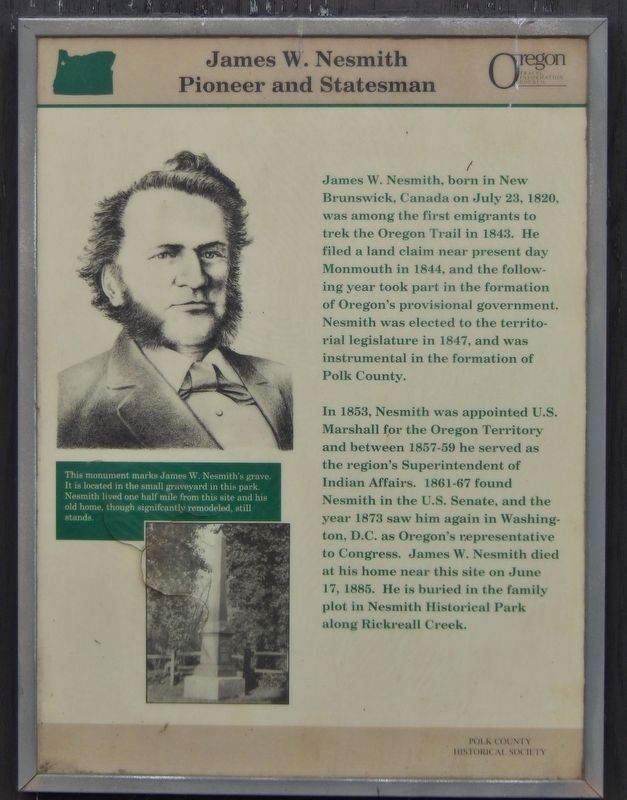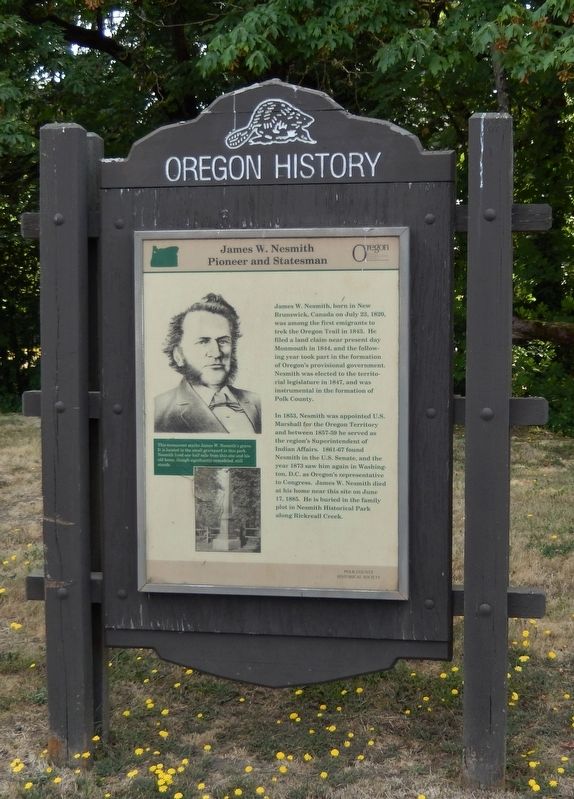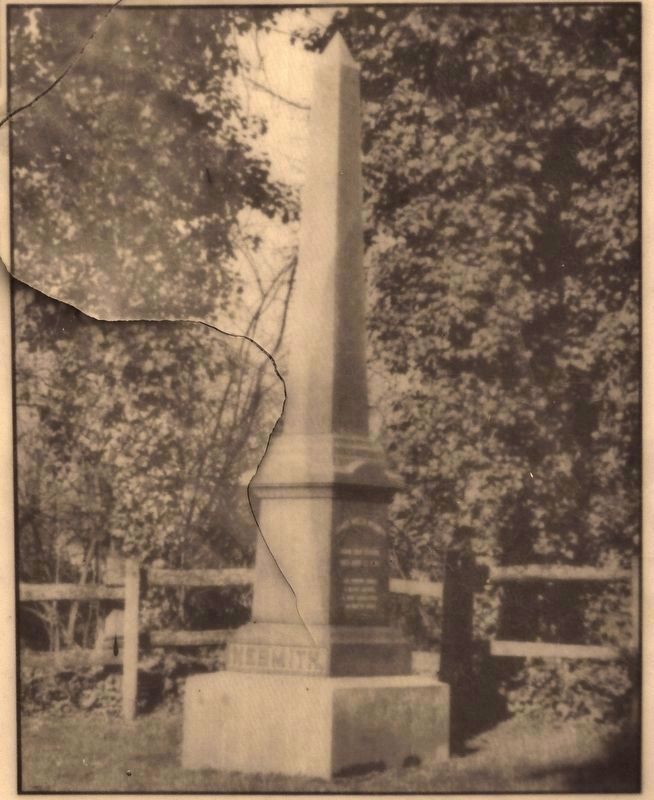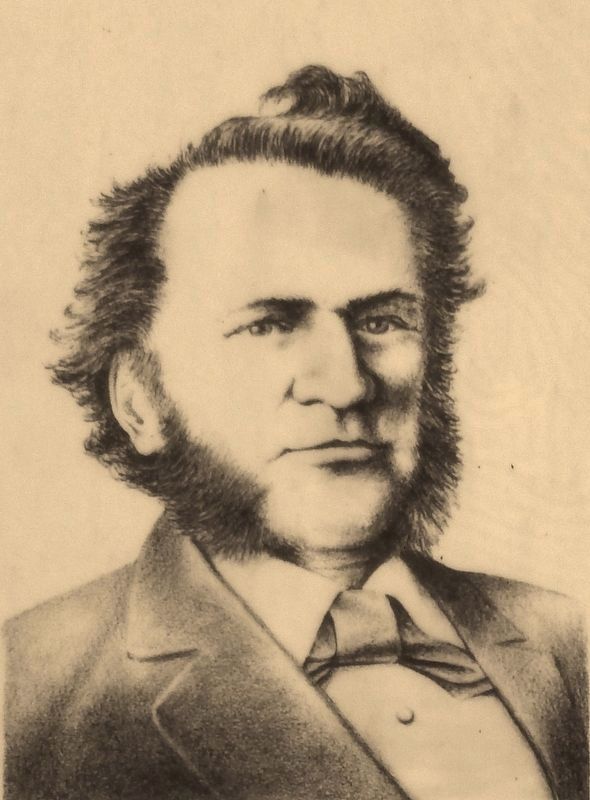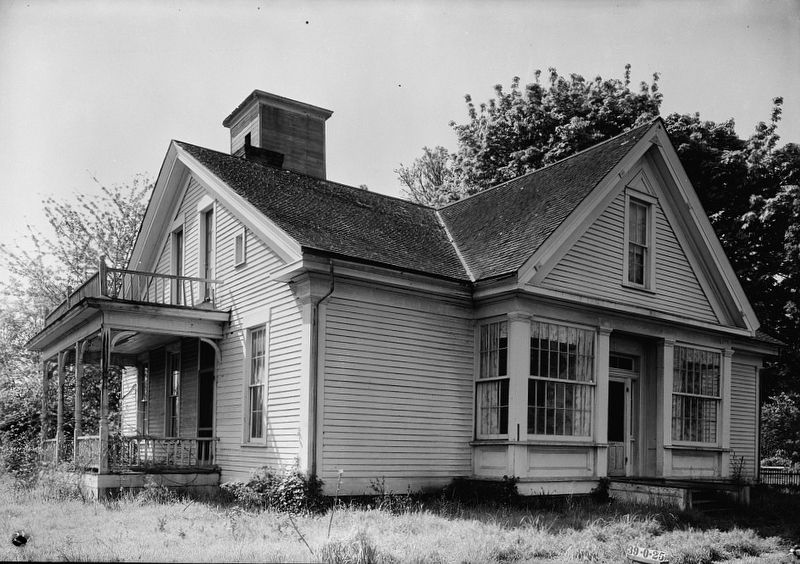Rickreall in Polk County, Oregon — The American West (Northwest)
James W. Nesmith
Pioneer and Statesman
James W. Nesmith, born in New Brunswick, Canada on July 23, 1820, was among the first emigrants to trek the Oregon Trail in 1843. He filed a land claim near present day Monmouth in 1844, and the following year took part in the formation of Oregonís Provisional Government. Nesmith was elected to the Territorial Legislature in 1847, and was instrumental in the formation of Polk County.
In 1853, Nesmith was appointed U.S. Marshall for the Oregon Territory and between 1857-59 he served as the regionís Superintendent of Indian Affairs. 1861-67 found Nesmith in the U.S. Senate, and the year 1873 saw him again in Washington, D.C. as Oregonís Representative to Congress. James W. Nesmith died at his home near this site on June 17, 1885. He is buried in the family plot in Nesmith Historical Park along Rickreall Creek
Erected by Polk County Historical Society. (Marker Number V9.)
Topics and series. This historical marker is listed in these topic lists: Government & Politics • Settlements & Settlers. In addition, it is included in the Oregon Beaver Boards series list.
Location. 44° 55.603′ N, 123° 13.7′ W. Marker is in Rickreall, Oregon, in Polk County. Marker is at the intersection of Pacific Highway West (Oregon Route 99W) and Burch Grove Lane, on the right when traveling north on Pacific Highway West. Marker is located in pull-out on the east side of the highway, just north of the Polk County Fairgrounds. Touch for map. Marker is at or near this postal address: 520 South Pacific Hwy W, Rickreall OR 97371, United States of America. Touch for directions.
Other nearby markers. At least 8 other markers are within 10 miles of this marker, measured as the crow flies. Polk County Fairgrounds Applegate Trail Kiosk (approx. 0.2 miles away); Welcome to Dallas (approx. 4.4 miles away); T.G. Bligh Building (approx. 9.4 miles away); Salem (approx. 9Ĺ miles away); Dedicated to You, A Free Citizen in a Free Land (approx. 9.7 miles away); Marking an Old Trail (approx. 9.7 miles away); Willamette University College of Medicine (approx. 9.7 miles away); Giant Sequoia (approx. 9.8 miles away).
Also see . . .
1. James Willis Nesmith.
In 1843, Nesmith arrived in Oregon where he studied law and was admitted to the bar before being selected to serve as Supreme Judge of the Provisional Government of Oregon in 1845. He finished his term in 1846 and moved to Polk County where he took a land claim, began farming. In 1847, he was elected to the Provisional Legislature of Oregon from Polk County. Nesmith next served as a captain during the Cayuse War against Native Americans in Eastern Oregon from 1847 to 1848. When news of the California Gold Rush reached the Willamette Valley in 1848, he traveled south to the gold fields, remaining until 1849. In 1849, he returned to Polk County where he purchased a flour mill on Rickreall Creek. He again was a captain in the militia forces during the Rogue River War in 1853 and the Yakima Indian War in 1855. Between the two wars he was the United States Marshal for the Oregon Territory, replacing Joseph Meek. From 1857 to 1859 he was the Superintendent of Indian Affairs for Oregon and Washington Territories. As Superintendent of Indian Affairs, Nesmith was aggressive against American Indians on Oregon's south coast, and once stated to Commissioner of Indian Affairs George Manypenny that the extermination of the Chetco people "would occasion no regrets at this office." (Submitted on February 2, 2018, by Cosmos Mariner of Cape Canaveral, Florida.)
2. A Polk Pioneer.
Col. James W. Nesmith, the namesake of the new Oregon Army National Guard Readiness Center in Dallas, also has been called "The Father of Polk County." Nesmith served as both a U.S. Senator and member of the U.S. House of Representatives, among other posts. Nesmith sometimes crossed party lines, supporting the abolition of slavery when elected to the United States Senate in 1860. A Democrat, he joined Republicans in calling for the end of slavery. Additionally, he was the only Democrat
in the Senate to vote for the resolution proposing the 13th Amendment to the Constitution, which abolished slavery. (Submitted on February 2, 2018, by Cosmos Mariner of Cape Canaveral, Florida.)
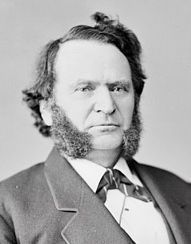
Brady-Handy Collection, Library of Congress, February 3, 2018
5. Nesmith, Hon. James Willis of Oregon
The Library of Congress dates this photo to 1865-1880; based on appearance, it is likely to have been the visual source for the drawing in the previous photo. (Note this photograph was cropped to match the drawing.)
Credits. This page was last revised on February 3, 2018. It was originally submitted on February 2, 2018, by Cosmos Mariner of Cape Canaveral, Florida. This page has been viewed 321 times since then and 30 times this year. Photos: 1, 2, 3, 4. submitted on February 2, 2018, by Cosmos Mariner of Cape Canaveral, Florida. 5, 6. submitted on February 3, 2018. • Andrew Ruppenstein was the editor who published this page.
